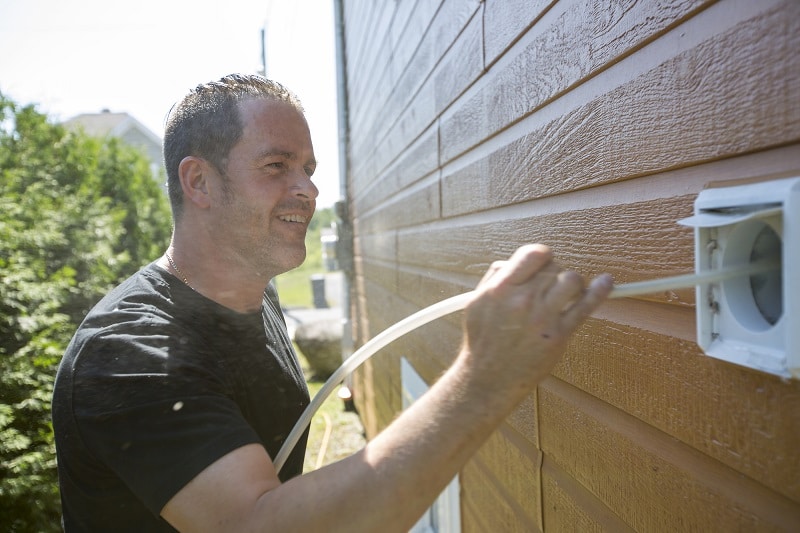Dryers are just the real deal when it comes to drying your wet laundry. They get the job done in less time than the traditional way of hanging clothes to dry in the sun. However, just like any other machine, a dryer requires regular maintenance.
Dryers have filters that trap lint generated by the dryer when drying out the laundry. Sometimes these filters do not catch all the lint produced that ends up clogging the vent, which is a very big hazard in households. This is because when the ducts are clogged, it leads to overheating that can ignite the lint.
According to the US Fire Administration, every year there are an average of 2,900 home fires caused by clothes dryers, with the leading cause of 34% of those fires being due to dirty dryer vents. Studies by the National Fire Protection Association also show that dust, fibers, and lint are the most common reason for dryer fires which have caused millions of dollars in property damage, as well as many deaths. The saddest thing about these statistics is that most of these fires could have been avoided with proper maintenance and cleaning.
In order to prevent a fire in your home, you need to do more than clean the lint trap (which should be done every time you start a new load of laundry. Let’s take a look at the steps to take when cleaning your dryer vent.
You May Also Like: How to Clean a Microwave Oven
When to Clean the Dryer Vent
Having used your dryer for quite some time, it wouldn’t be hard to notice when it’s not functioning as usual. Every laundry load that goes through the dryer generates lint that doesn’t get filtered out completely more often than not. Whatever is not filtered out makes its way through the dryer ductwork to the vent opening, creating a blockage.
There are danger and warning signs that you will notice while using the dryer, indicating it’s time to clean the vent thoroughly. Let’s take a look at some of them.
- Your clothes will probably take longer to dry or will not even fully dry. This may require you to put them in the dryer two or three more times.
- Your clothes will not have a normal temperature and tend to be hotter than usual at the end of a drying cycle.
- During the drying cycle, the outside of the dryer becomes very hot.
- When drying your clothes, a smell like that of something burning becomes very evident.
- Your laundry room may feel more humid than usual.
- The exhaust vent flapper becomes difficult to open, indicating that there might be low exhaust velocity.
While this list of “symptoms” is great to know, you should NOT wait until you notice issues. Fire safety experts recommend that you should clean your dryer vent system every three months.
Steps for Dryer Vent Cleaning

Before cleaning your dryer, it is important to understand the type of dryer you have to take all the necessary precautions. This means you need to find out whether your dryer runs on gas or electric power. An electric dryer will have a larger plug than the standard plug and an electrical outlet, while a dryer running on gas will connect to a gas valve and plug into a standard 110-volt outlet. Where the dryer is running on gas, it is of utmost importance while cleaning to turn off the gas supply valve and ensure not to disturb the flexible line.
To clean the dryer vent, you will need a dryer vent cleaning kit, which can be bought in a local hardware shop or online, a power drill, a vacuum with a long hose attachment, and a screwdriver. You may also need UL-listed metal foil duct tape to reconnect the inside dryer vent tube or repair any leaks.
When you have gathered all your equipment ready, you can now start cleaning your dryer vent. The following are the key steps to follow when cleaning.
1. Where Is The Vent?
To clean your dryer vent properly, you will need to find out where it is actually located. Dryer units have a short 4-inch diameter exhaust that connects to ductwork inside the wall. Hot air is released from your dryer into the pipe and escapes through the vent outside the wall of your house. Once identified, look inside for any debris, dead bugs, or debris.
2. Disconnect the Dryer Carefully
You will start by disconnecting your power cord from the wall depending on when using an electric dryer. Any clamps or metal tape attaching your dryers’ vent pipe to the exhaust should be removed. Gentle pressure should be applied to ensure nothing breaks in the process. For those using a gas dryer, proper caution needs to be made, ensuring the gas line is not disturbed, and no leakage occurs.
3. Clean the Lint
At this point, one can have a clear look inside the dryer vent. Vacuum any lint inside or around the hole using a long, skinny hose attachment for the vacuum cleaner. After vacuuming, follow with a long brush and push it down the duct to clean any remaining lint that has not been vacuumed. The brush works best when attached to a power drill. Repeat inserting the brush as many times as needed until the lint is all cleaned up.
Once you are finished cleaning the dryer vent duct, you should also clean down inside where the lint filter goes. To make this job simple, you can use a special dryer vent vacuum attachment.
4. Reconnect Everything And Tidy Up
At this juncture, you probably have unearthed a whole heap of lint. You would want to tidy up that mess using a dustpan and broom to sweep away. After cleaning up, reconnect your wall duct and plug your dryer into the outlet. Seal all the permanent sections with duct tape and replace any flexible ductwork that appears not exposed to the metal ductwork. Once everything is back in place, turn on the gas valve and plug in the dryer for gas dryers.
5. Celebration And A Trial Run Maybe?
You are done! Without a doubt cleaning a dryer vent is not so pleasant. However, a clean dryer vent gives you the ultimate energy and right mood to get that laundry done. It would be nice to turn on the dryer and just listen to airflow smoothly out of the vent. That would be the absolute confirmation that you will have your clothes dry and the laundry room smelling dry and no more unending cycles of drying clothes. Now, that’s what we call success!
We hope these simple instructions have been useful. Please, don’t put off cleaning your dryer vents. It’s a messy job, but an extremely important one for the safety of you, your family, and your home.
- U.S. Fire Administration: Clothes Dryer Fire Safety (also available in Spanish)
- National Fire Protection Association: Clothes Dryer Safety

